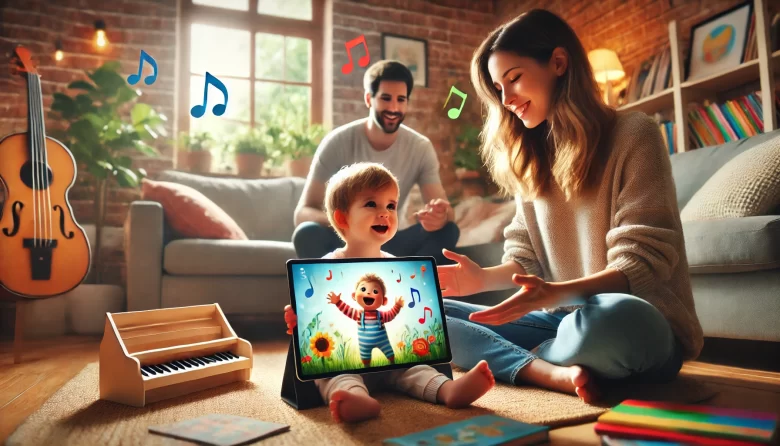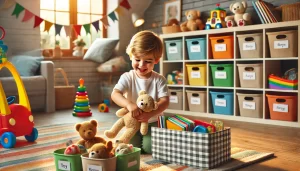Children are naturally drawn to videos and music, making them powerful tools for learning at home. Whether through educational songs, interactive videos, or animated storytelling, audiovisual content can enhance learning by engaging multiple senses and making complex concepts easier to understand.
But how can parents effectively use videos and music for early childhood education without relying too much on screens? In this comprehensive guide, we’ll cover:
✅ The benefits of using videos and music for learning
✅ The best types of educational videos and songs
✅ How to integrate videos and music into daily learning routines
✅ Practical strategies to ensure active engagement
✅ A curated list of the best educational video channels and music resources
Let’s dive in! 🎶📺
Why Use Videos and Music for Early Learning?
The Science Behind Learning Through Music and Videos
Research shows that music and visual storytelling help young children:
🎵 Improve memory and retention – Melodies and rhythms make it easier for children to remember new words and concepts.
🎥 Engage with learning actively – Interactive videos encourage participation and reinforce new ideas.
🗣 Enhance language skills – Exposure to music and videos improves pronunciation, vocabulary, and listening comprehension.
🧠 Stimulate cognitive development – Songs and storytelling support problem-solving, emotional intelligence, and creativity.
Choosing the Right Educational Videos and Music
Not all videos and songs are educational or beneficial. Here’s what to look for:
🎥 Key Features of High-Quality Educational Videos
✅ Encourages active learning – Promotes singing along, answering questions, or acting out movements.
✅ Simple and clear visuals – Avoid overly fast-paced or overstimulating content.
✅ Teaches valuable concepts – Videos should cover literacy, math, science, or social skills.
✅ Short and engaging – 3 to 10-minute videos work best for young learners.
✅ Includes repetition – Repeating words, phrases, and concepts helps reinforce learning.
🎵 Key Features of High-Quality Educational Music
✅ Catchy and easy to sing along – Simple lyrics help children memorize words and patterns.
✅ Teaches rhythm and movement – Interactive songs encourage dancing and coordination.
✅ Introduces new vocabulary – Music helps expand a child’s language skills naturally.
The Best Types of Educational Videos and Music for Kids
📺 Best Types of Educational Videos
| Type | Examples |
|---|---|
| Phonics & Reading | ABC Mouse, Sesame Street, Alphablocks |
| Math & Numbers | Numberblocks, Jack Hartmann, Scratch Garden |
| Science & Nature | National Geographic Kids, SciShow Kids |
| Social Skills & Emotions | Daniel Tiger’s Neighborhood, Super Simple Songs |
| Cultural & Multilingual | Songs in Spanish, French, and sign language (e.g., Canticos, Little Pim) |
🎶 Best Types of Educational Music
| Category | Examples |
|---|---|
| Alphabet & Phonics Songs | Super Simple ABCs, Singing Walrus |
| Counting Songs | “Five Little Ducks,” “Ten in the Bed” |
| Movement & Action Songs | “Head, Shoulders, Knees, and Toes,” “If You’re Happy and You Know It” |
| Social-Emotional Learning | “The Feelings Song,” “Daniel Tiger’s Stop & Go” |
| Foreign Language Songs | “Los Pollitos Dicen” (Spanish), “Frère Jacques” (French) |
By using a variety of videos and songs, parents can introduce new concepts in fun and memorable ways.
How to Integrate Videos and Music into Learning at Home
🕒 Creating a Daily Learning Routine
Here’s how to balance music, videos, and offline activities throughout the day:
📌 Morning Wake-Up Song – Start the day with an energizing song like “Good Morning, How Are You?”
📌 Learning Time Video – Watch a short phonics or math video. Encourage interaction (e.g., pausing to repeat words).
📌 Creative Play with Music – Play an instrumental song and let your child dance, act out a story, or draw.
📌 Quiet Time with Storytelling Videos – Wind down with a calm storytelling video before naptime.
📌 Sing-Along Before Bed – End the day with a soothing lullaby or a quiet song.
Strategies to Ensure Active Engagement
🎭 Turn Videos into Interactive Lessons – Pause to ask questions, encourage role-playing, or act out the story.
🎤 Sing Together – Make sing-alongs a daily activity. Encourage hand motions and dance moves.
📚 Combine Videos with Books – Read a book after watching a related video to reinforce concepts.
🎨 Create Art Inspired by Songs – After listening to a song, let your child draw a scene from it.
🧩 Incorporate Music into Daily Tasks – Sing songs while cleaning up or getting dressed to make routines fun.
By actively involving children, music and videos become more than just passive screen time—they become tools for deeper learning.
Top Educational YouTube Channels & Music Resources for Kids
📺 Best YouTube Channels for Educational Videos
- Super Simple Songs – Fun and interactive learning songs.
- Sesame Street – Teaches letters, numbers, and social skills.
- Khan Academy Kids – Free educational videos covering math and literacy.
- SciShow Kids – Science lessons made fun and easy to understand.
- Alphablocks & Numberblocks – Phonics and math lessons through animation.
🎶 Best Streaming Platforms for Educational Music
- Spotify & Apple Music – Playlists like “Preschool Learning Songs” and “Baby Shark & Friends.”
- Pandora Kids – Family-friendly music streaming for early learners.
- Amazon Music Kids – Offers themed playlists like bedtime songs and learning songs.
By choosing reliable sources, parents can ensure their children are learning from the best educational content available.
The Future of Videos and Music in Early Learning
The role of videos and music in early education is evolving, with exciting new trends on the horizon:
🚀 Augmented Reality (AR) Storytelling – Apps that allow children to interact with digital characters in real-time.
🤖 AI-Personalized Learning Playlists – Platforms that adjust video and song recommendations based on a child’s progress.
🎭 Multisensory Learning Experiences – Combining video, music, and physical movement for deeper engagement.
As technology continues to advance, videos and music will play an even greater role in personalized and immersive learning experiences.
Final Thoughts
✔ Music and videos are powerful tools for teaching young children—when used mindfully.
✔ Choose high-quality content that promotes active learning and engagement.
✔ Balance digital learning with real-world activities like dancing, reading, and storytelling.
✔ Encourage participation by singing along, asking questions, and acting out scenes.
✔ Make videos and music part of a structured routine to support learning without excessive screen time.
By using these strategies, parents can create a rich and engaging learning environment at home that blends music, videos, and hands-on activities for a well-rounded educational experience.




